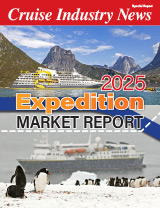The recently detected record low level of Arctic ice cover will make this area available for shipping activity at an earlier stage than previously predicted. New opportunities will then be created – new opportunities that require a new approach to safety.
“Since we foresee increasing shipping activity in the northernmost waters, we cannot continue to build on our traditional safety approach. There are additional hazards in the Arctic compared with any existing sea routes and the consequences of failure are greater. We have to be proactive, and we have to prepare for a safety regime that focuses on the technical as well as the human elements,” said Tor Svensen, COO of DNV Maritime at a press conference in Hamburg today. “We have to build new barriers of safety in order to reduce risks”.
Satellite pictures taken two weeks ago show the lowest extent of ice cover ever detected in the Arctic. The anticipated industrial activity relating to mining, fossil fuel extraction, industrial scale fishing and increased shipping in the region is growing. Arctic Circle nations like Canada, Denmark, Norway, Russia and the United Sates have also increased their focus on the undersea economic zones.
Within the next four to six years, approximately the same time span needed to plan and build an ice-breaker, the Arctic region will have changed significantly, opening up business opportunities for forward-thinking members of the shipping industry.
“The speed of this development is faster than at any time before, and we all have to be aware of how soon Arctic opportunities will materialise. There will be business opportunities, but since the environment in this part of the globe is very vulnerable and both the vessels themselves and the humans operating them experience a high level of stress, we have to reduce risk to a minimum,” says Tor Svensen, COO of DNV Maritime.
Svensen confirmed that DNV has taken action to boost its Arctic-related class activities. “We are increasing our class competence relating to construction, design, equipment, manning and navigation standards. We are also looking more closely at contingency planning and preparedness standards, vessel routing measures, reporting systems and traffic services.”
Some 1,900 vessels carry DNV ice class notations, including the four highest-specification LNG carriers in operation. DNV class notations cover the entire spectrum of cold climate operations, ranging from control of icing in open waters to ice-breaking abilities in temperatures as low as -55oC. And in recognition of the rapidly changing physical and business environments in the Arctic, the optional notations like winterisation are becoming more and more relevant.



